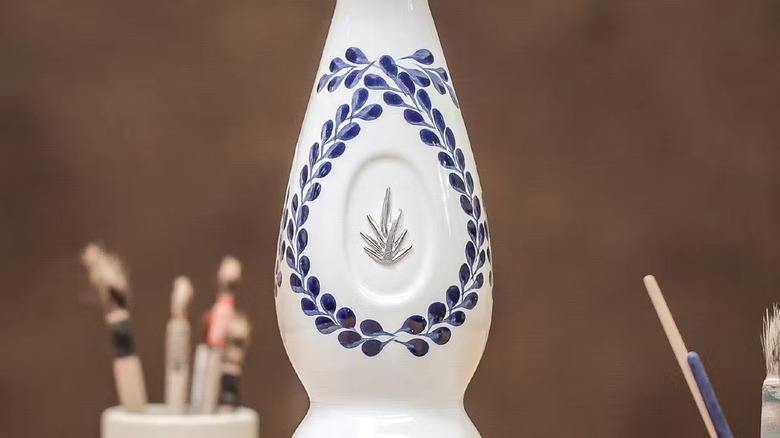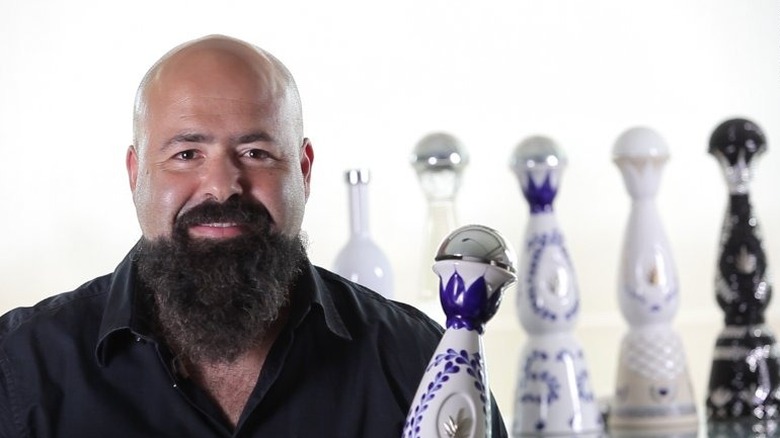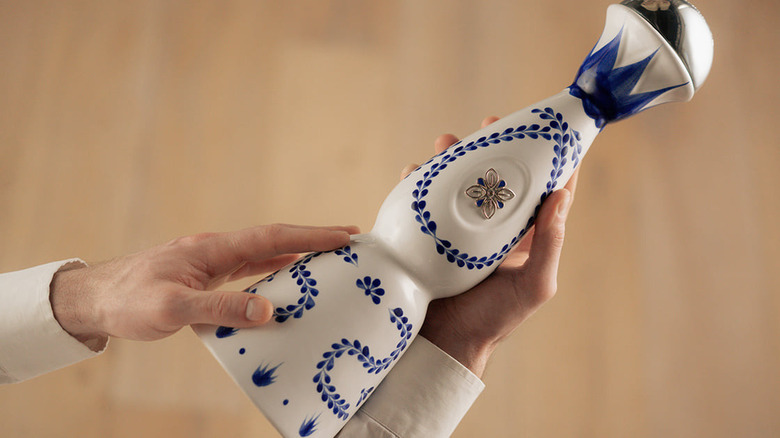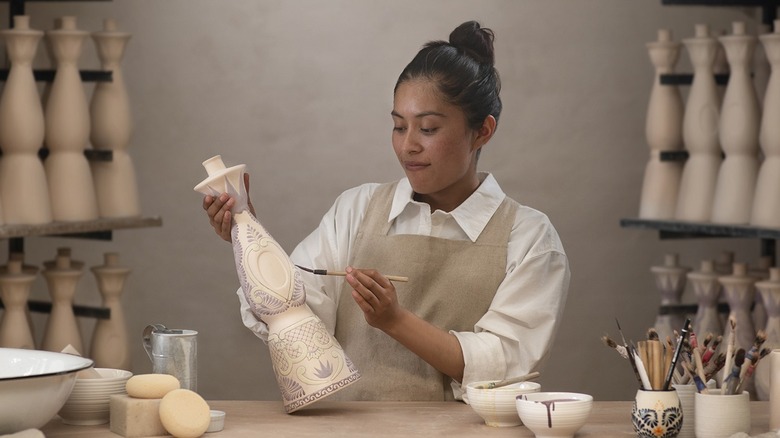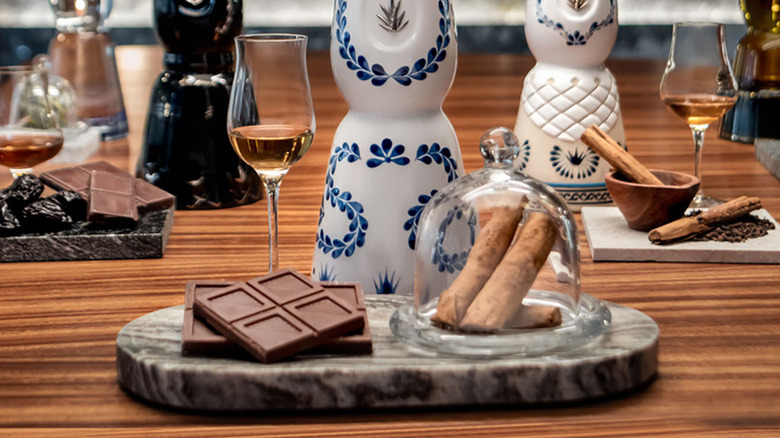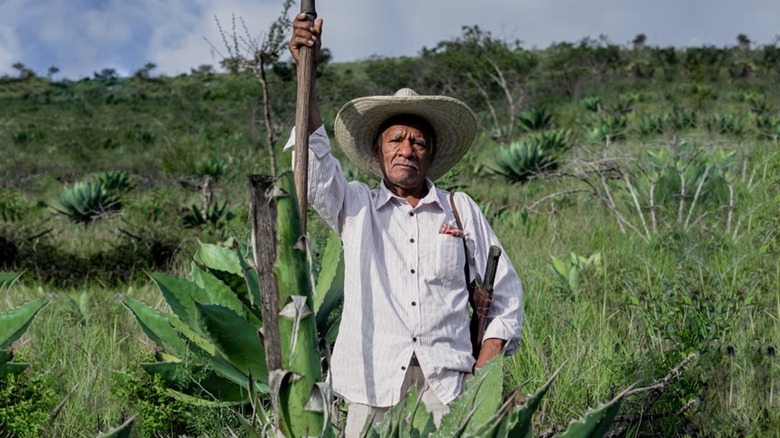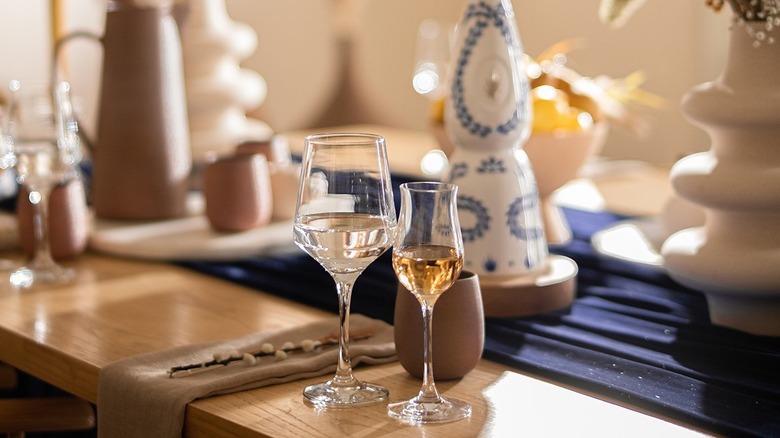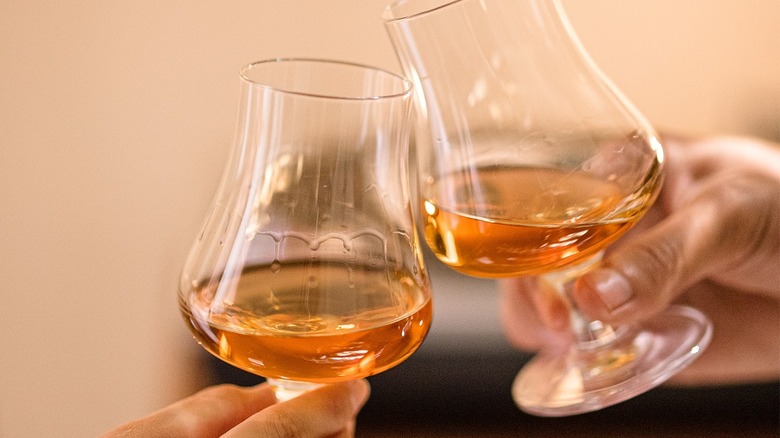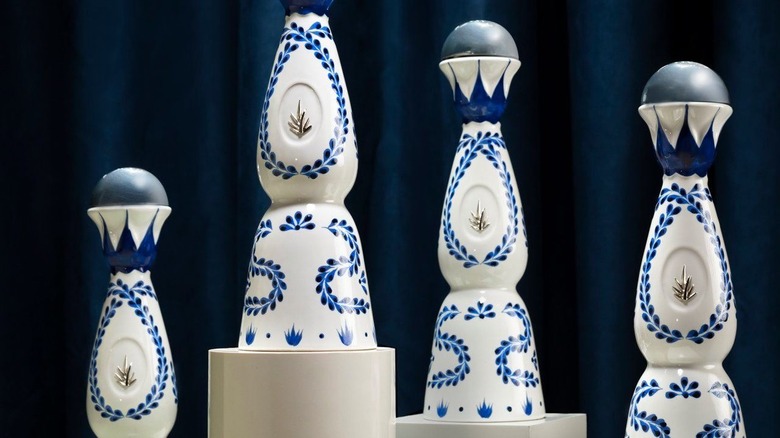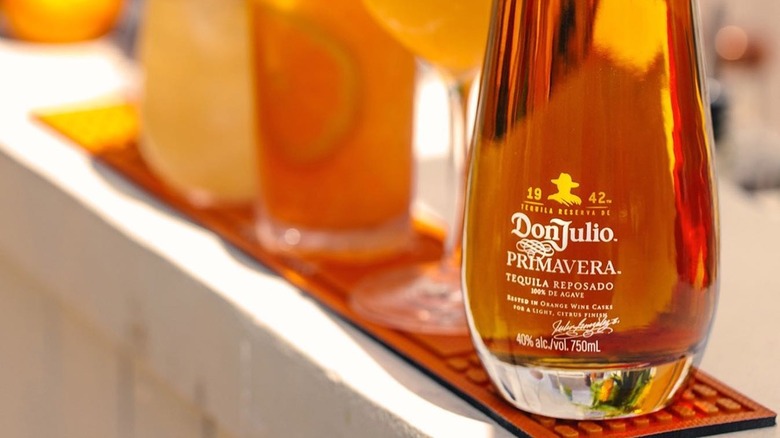Clase Azul Reposado Tequila: The Ultimate Bottle Guide
Of all of the tequilas taking part in the spirit's recent popularity surge, Clase Azul Reposado has emerged and established itself as a standard for taste, quality, and craftsmanship. This is no simple feat, however, as tequila is slowly becoming America's favorite spirit, whether you're sipping it over ice or pouring it in a mixed drink. According to northjersey.com, tequila consumption in the United States increased by more than 40% since 2017, and tequila sales have grown by over 50% year-to-year since July 2020. Today, the spirit is the foundation of a $1.25 billion-per-year industry.
Although the tequila boom is only just beginning, Clase Azul has been doing what it does best for decades, and its reposado is the brand's flagship bottle. Not only is every single bottle of Clase Azul Reposado a handcrafted, one-of-a-kind work of art, according to the site, but the contents of each bottle also undergo a process dedicated to excellence and artistry. Clase Azul Reposado honors the land, resources, people, and traditions responsible for producing such an exceptional final product.
History of Clase Azul Reposado
According to Forbes, Clase Azul was founded in 2000 by Arturo Lomeli, who has since fulfilled his mission of producing high-end tequila built by authenticity. Lomeli grew up in Guadalajara, the state capital of the home of tequila, Jalisco. In 1997, at age 24, Lomeli took a shot in the liquor business through a bar venture, which he quickly realized was not for him. In search of a way forward, Lomeli returned to school and, in 1999, discovered just that.
Lomeli studied and practiced both tequila-making and ceramics before deciding to call his new company "Clase Azul," an ode to a popular Mexican telenovela called "Azul Tequila." In 2000, Forbes notes, the very first bottle of Clase Azul Reposado was filled and hit the market. Since then, Clase Azul Reposado has been the company's iron horse. While other bottles are filled with different types of tequila or are released as special editions, it's Lomeli's reposado that set the bar and continues to raise it over twenty years on.
In 2019, Lomeli and his longtime business partner, Juan Sanchez, received an offer for Clase Azul for $1 billion, Forbes reports. They turned it down. Evidently, the brand is not for sale, and the owners value a hands-on approach (a dedication that has contributed to their success).
It's the world's most wanted tequila
Every year, Wine-Searcher publishes a list of the most popular products in a given category. Between March 2021 and March 2022, the ten most wanted tequilas included three products by Clase Azul. It was their reposado, however, that topped the list altogether. Despite Jose Cuervo's market dominance and the influx of celebrity-owned and advertised tequilas now available, Clase Azul Reposado remains at the apex of its class.
Within that same 12-month time frame, tequila searches on Wine-Searcher increased by over 250%. This comes as no surprise as the spirits and cocktail renaissance of the past couple of decades has been mostly driven by tequila. What used to be considered a cheap option used only for hasty intoxication has seen its revival from the back of the bar to being sipped and enjoyed neat.
Additionally, the price tag on these newly appreciated bottles does not seem to matter, according to Wine-Searcher. People are clearly putting their money forward to taste these premium spirits and do not seem to be doing so based on any celebrity cachet. Instead, it is the product with a dedication to quality that is leading the way. Clase Azul Reposado tops this list because of characteristics you will not find in a commercial or photo shoot. They can only be found by holding the bottle in your own hands and experiencing the fruits of its labor yourself.
Every bottle is handcrafted
Premium spirits on the market come in a wide range of shapes with different decorations or special features on or inside the packaging. High-end tequilas are thriving, and the packaging they come in can be just as creative and unique as any other spirit. The one thing that unifies most of them, however, is they are all glass — but not Clase Azul Reposado.
According to Paste Magazine, the artists who sculpt every bottle of Clase Azul Reposado come from Santa Maria Canchesda, a village that champions the art of pottery. Not only is every bottle of Clase Azul a hand-sculpted and painted piece of clay, but they are also each one of a kind because of the irregularities of the craft.
It takes 11 days to make each bottle, according to Forbes. The process includes forming a cask mold out of the soil which is then polished, glazed, and painted before baking in a 2,100 degree Fahrenheit oven. Clase Azul Reposado bottles are not slapped with a label, either — another upheld tradition of making tequila. The hard work and attention to detail that goes into each bottle rightfully take center stage.
When Arturo Lomeli founded Clase Azul in 2000, reinforcing this art form was part of his agenda, according to Forbes. He said, "I knew artisans were all over Mexico and that their craft was struggling to survive in the wake of machine-made products ... it made perfect sense to fuse the two together."
Dessert pairings are recommended with Clase Azul Reposado
A spirit can fulfill a variety of purposes, whether it be sipped before a meal to prepare your appetite, after a meal to bring it to a close, or any place in between. Tequila is typically enjoyed in bright and refreshing cocktails, but Clase Azul actually recommends that a tequila as high-quality and decadent as its reposado be accompanied by a dessert.
In addition to being paired with a rich cut of pork or creamy, aged cheese, Clase Azul suggests its reposado sit alongside a bittersweet chocolate mousse with hazelnut and orange. Because reposado tequila is aged, it carries flavor notes accumulated from the wooden container it sits in. Clase Azul Reposado is aged in American oak barrels, the same used for bourbon whiskey, which gives the reposado deep, warm flavor notes, like caramel and vanilla. These sweeter flavors are well-balanced and enhanced with bittersweet chocolate of 78% cacao, according to Lindt.
There are dessert cocktails and spirits meant for after the meal entirely. Of course, Clase Azul Reposado is delicious enough to not require any sidekicks, but a luxurious pairing of select chocolate with this premium tequila is just another reason why Clase Azul Reposado stands apart from the pack.
How is Clase Azul Reposado made?
Clase Azul Reposado is distilled from 100% blue agave at one of the highest altitudes in Mexico. The higher altitude contributes a unique tequila flavor because of the climate and soil. All agave used for Clase Azul Reposado is grown between six and eight years before it is harvested, its core removed, and prepared for cooking. The cooking process takes three days and is done in old masonry ovens. This cooking of the agave core brings out the iconic sweetness in the spirit. The cooked agave core is pressed and extracted from all of its moisture, which is separated and transferred for fermentation with proprietary yeast. The tequila is then distilled twice to achieve a perfect balance of flavors and the best possible quality, the site notes.
The word "reposado" means "rested" in English. In the case of Clase Azul Reposado, that resting period takes place in American whiskey barrels for a total of eight months. This is where the reposado accumulates its color, texture, and most of its flavor. The fibers of the oak casks infuse the tequila with a soothing warmness and extraordinary smoothness, according to Clase Azul.
Finally, the reposado fills the expertly crafted ceramic bottles made with ancient techniques honoring the artists' and land's rich ancestry. Everything from the soil that springs forth, to the agave, to the finishing touches carefully made on each bottle makes Clase Azul Reposado a product of the dedication to excellence and cultural reverence.
What does Clase Azul Reposado taste like?
Every aspect of Clase Azul Reposado makes it unlike any other tequila, and its taste is no exception. According to 31 Whiskey, the aromas include those of traditional tequila such as sweet agave and herbs. Still, those notes are enhanced even further with that of caramel, cinnamon, nutmeg, and vanilla. This depth and complexity are normally only found in high-quality añejo tequilas, which are aged for a longer amount of time. Clase Azul Reposado, however, encapsulates and exceeds that same profoundness.
After opening with an initial rich sweetness from the cooked agave, the mid-palate is introduced to aged oak with hints of orange peel before a toasty conclusion is rounded out and elongated by spice and rich vanilla, Liquor reports. The layered experience of every sip brings something fresh each time, and those ever-evolving recollections are what make Clase Azul Reposado a gift that keeps on giving.
The flavor of Clase Azul Reposado is dense, layered, and complex. However, the experience of holding this special bottle in your hand, removing its cap, and sharing it with your friends or family all while being aware of where it comes from and what it represents makes for an intangible quality.
How should you drink Clase Azul Reposado?
While there is an endless amount of delicious tequila cocktails, Clase Azul Reposado deserves to be sipped on its own, according to Liquor. Therefore, how you store it, what glass you choose to fill with it, and the amount you pour all contribute to this world-class spirit fulfilling its maximum potential.
After you get your hands on a bottle, it is best stored in a location of moderate temperature void of any direct sunlight. It is not necessary to refrigerate it, either. After all, the beautiful Clase Azul Reposado bottle should be out in the open for all to admire.
The best way to enjoy Clase Azul Reposado is neat. If your palate prefers a colder spirit, a chilled glass is your best option to achieve a comfortable sip while avoiding any disruptive dilution. Furthermore, the glass you choose can be just as important. The aromas of Clase Azul Reposado contribute immensely to its flavor, so shot glasses are not ideal, according to Liquor. Instead, a wider-rimmed glass, such as a wine glass or whiskey snifter, is best because of its accessibility for the nose to inhale all of the tequila's aromas.
As always, how you drink Clase Azul Reposado — or anything for that matter — is up to your preference. There may be guidelines and techniques that claim to enhance your experience, but the fundamental purpose and requirement of Clase Azul Reposado is enjoyment.
How much does Clase Azul Reposado cost?
According to Wine-Searcher, the average price of a bottle of Clase Azul Reposado is $174. The price is definitely on the higher side, but the purchase of this tequila should be looked at as an investment. This is not an investment for monetary returns, however, but an investment that will mark milestones for years to come, so long as it is stored properly, according to Liquor.
This tequila is not meant to be consumed mindlessly and fleetingly. Clase Azul Reposado is meant to stamp the extra special days of your life. Whether that be on a day a life begins, when two merge together, or even when one comes to an end, this tequila is for celebration and togetherness.
Clase Azul Reposado is the king of tequila. The cultivation of ingredients and the skills of the people devoting their craft to it results in a product of unparalleled taste and presentation. Every component that goes into Clase Azul Reposado contributes to this price point, but that intangible quality that comes with each bottle can be best described as priceless.
Clase Azul Reposado vs. Don Julio Primavera
Clase Azul Reposado is undoubtedly at the top of its game, but of all high-end tequilas on the market, Don Julio Primavera is its most worthy competitor. Don Julio crafts its own wide range of upscale tequilas, and Don Julio Primavera is its shining reposado.
Unlike Clase Azul Reposado, Don Julio Primavera is aged in wooden casks from Europe that were previously used to store wine. The barrels are infused with macerated orange peel, which brightens the tequila into a wonderfully smooth, vibrant spirit. Also, unlike Clase Azul Reposado, Don Julio recommends its Don Julio Primavera be mixed in a cocktail, such as its original "Primavera Sunset" (via its site). Originally released as a special edition last year, Don Julio Primavera is back again this spring in another limited release.
According to Wine-Searcher, the average price of Don Julio Primavera is $159, about $20 less than Clase Azul Reposado. A more important difference between the two spirits, however, is the bottle they come in. Don Julio Primavera is packaged in a very stylish, sleek, eye-catching glass bottle. It is a beautiful design, but the hand-crafted work of the artisans at Clase Azul paying tribute to the traditions that precede them should not go overlooked. Don Julio Primavera is a well-made, delicious tequila that is definitely worth trying and available within the same price range, but Clase Azul Reposado remains number one without a doubt.
